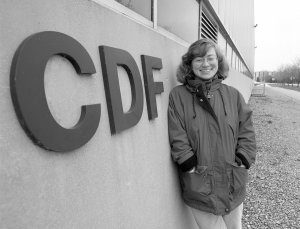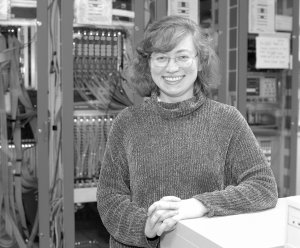 |
|
View from the Top by Natalia Kuznetsova
I am from Minsk in Belarus, which is a small country west of Russia and east of Poland, and north of Ukraine. I came to the U.S. in 1993, as an undergraduate exchange student at Kenyon College in Ohio. The exchange program was supposed to last only a year, but the college gave me a full scholarship for the following year, so that I could stay and graduate with the class of 1995. I then went on to grad school in California.
I never had any doubts that, at this point in my career, I had to be at Fermilab. Yet when I arrived as a Lederman Fellow, a little over two months ago, I had no idea what I would be working on for the next three years or so. As a Fermilab postdoc, I was free to join any experiment within the Fermilab program; I had 30 days to decide. Should I study neutrinos? The mysterious cold dark matter? The properties of the top quark? Cosmic rays? I came to Fermilab to learn something new and different from what I had studied as a graduate student; but I knew very little about any of these experiments. The more I looked into what they did, the more each one interested me. I was reminded of a feeling I had as a child, when my parents would take me to a toy store for my birthday and tell me I could choose any doll I wanted —but no more than one!
I spent the first month at Fermilab driving all over the site, meeting new people, talking to them about what they did, trying to see whether I could contribute to their projects. This was great fun. It also gave me a chance to learn my way around Fermilab—I was unprepared for how huge it was, much bigger than the laboratory where I worked as a graduate student. I loved the view from the 15th floor of Wilson Hall. The fall landscape, with trees just starting to change color, looked so peaceful and serene, and yet the most dramatic events were happening in the two giant rings down below: particles accelerating to almost the speed of light, moving faster and faster. as they circled around the rings—until finally colliding in tremendous bursts of energy, with new particles born and quickly destroyed in the process.
I joined CDF while the experiment was in the midst of commissioning the upgraded detector for Collider Run II, which started last spring. The upgraded detector looks very different from what it was during Run I, lasting from 1992 to 1996, and people have to make sure that the upgraded detector subsystems function properly. A few weeks after I joined CDF, the Tevatron shut down its beams for about seven weeks. This was the last chance for people to have access to the detector and fix problems before it would be closed up again for continuous data taking until 2004 or beyond. My new collaborators worked hectically around the clock, and there was a great deal of excitement in the air.
However, I was not part of that excitement – not yet. My job was to decide what I could do at CDF. One system I found especially intriguing was the trigger, a highly complex electronic structure that decides whether or not a given proton-antiproton collision is particularly interesting from a physics point of view. In Run II, there will be millions of collisions happening each second, and it will be impossible to record every one of them: not only would it require some incredibly fast technology for getting the data out, but the data would fill hundreds of thousands of terabytes (trillions of bytes) of disk space in just one year.
Fortunately, many collisions are relatively well-understood processes that can be ignored in favor of something more exciting, and the trigger must decide what “exciting” means. CDF uses a three-level trigger system, with each level providing a greater degree of filtering than its predecessor. In Run II, the second level trigger, in particular, is designed to identify processes that have never before been accessible in a proton-antiproton environment. It is therefore extremely important to make sure that this trigger is capable of handling the very large number of collisions that are expected when Run II is in full bloom, and I was delighted when I saw an opportunity to contribute to this project.
Of course, not everything went smoothly for me during those first few weeks. There are some things I am still struggling with, but none of them matter at all when it comes to the main reason I am here at CDF: the physics. CDF, together with the other Tevatron experiment, DZero, functions at the highest energy available anywhere in the world. It is expected that the data set collected during Run II will be about 10-20 times larger than that accumulated during Run I, and the Tevatron energy in Run II will be about 10 percent higher.
It was only six years ago, here at the Tevatron, that the top quark was discovered by analyzing the Run I data. The last quark predicted by the Standard Model—our current best Theory of Everything—was now real. This discovery was yet another triumph in the already glorious 30-year old history of the Standard Model. I find it somewhat ironic that it may well be here in just a few years that the Standard Model will be faced with its most serious challenges. New, unexpected phenomena, a whole world of new particles and interactions, might be just around the corner; but we have to be at the energy frontier to get there. As contributor and student, I am excited and grateful to be part of the search.
|
| last modified 12/14/2001 email Fermilab |
FRLsDFx9eyfrPXgV
 Particle physicists strive for higher and higher energies for the same reason you would want to climb the highest mountain in a mountain range. As you are ascending, you catch glimpses of picturesque canyons and lovely green valleys down below, but the view is obscured by other mountains. Only when you get to the top do you see the full picture—and the view takes your breath away. I have a thrilling feeling that we are getting closer than ever to seeing the pieces of the puzzle called Nature fall together.
This is happening at Fermilab. I wouldn’t miss being here for the world.
Particle physicists strive for higher and higher energies for the same reason you would want to climb the highest mountain in a mountain range. As you are ascending, you catch glimpses of picturesque canyons and lovely green valleys down below, but the view is obscured by other mountains. Only when you get to the top do you see the full picture—and the view takes your breath away. I have a thrilling feeling that we are getting closer than ever to seeing the pieces of the puzzle called Nature fall together.
This is happening at Fermilab. I wouldn’t miss being here for the world.
 It was not an easy decision, but at the end I chose to join CDF, one of the two experiments operating at Fermilab’s powerful proton-antiproton collider, the Tevatron—the world’s highest-energy particle accelerator.
It was not an easy decision, but at the end I chose to join CDF, one of the two experiments operating at Fermilab’s powerful proton-antiproton collider, the Tevatron—the world’s highest-energy particle accelerator.